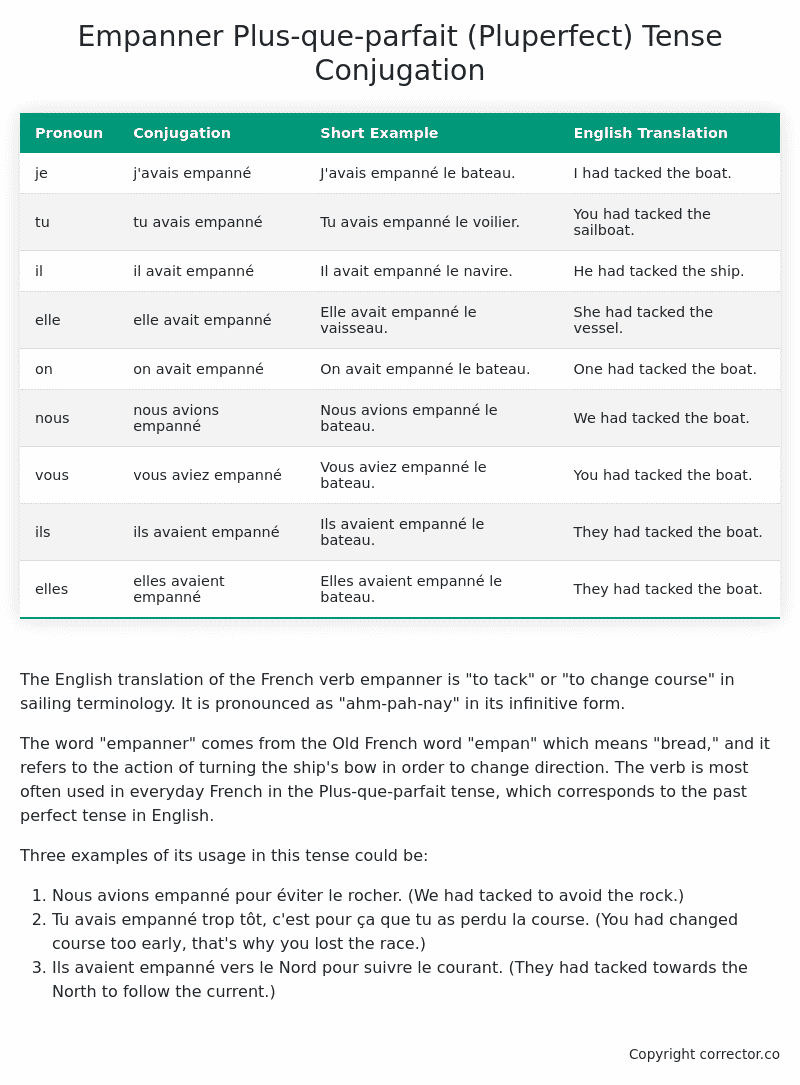Plus-que-parfait (Pluperfect) Tense Conjugation of the French Verb empanner
Introduction to the verb empanner
The English translation of the French verb empanner is “to tack” or “to change course” in sailing terminology. It is pronounced as “ahm-pah-nay” in its infinitive form.
The word “empanner” comes from the Old French word “empan” which means “bread,” and it refers to the action of turning the ship’s bow in order to change direction. The verb is most often used in everyday French in the Plus-que-parfait tense, which corresponds to the past perfect tense in English.
Three examples of its usage in this tense could be:
- Nous avions empanné pour éviter le rocher. (We had tacked to avoid the rock.)
- Tu avais empanné trop tôt, c’est pour ça que tu as perdu la course. (You had changed course too early, that’s why you lost the race.)
- Ils avaient empanné vers le Nord pour suivre le courant. (They had tacked towards the North to follow the current.)
Table of the Plus-que-parfait (Pluperfect) Tense Conjugation of empanner
| Pronoun | Conjugation | Short Example | English Translation |
|---|---|---|---|
| je | j’avais empanné | J’avais empanné le bateau. | I had tacked the boat. |
| tu | tu avais empanné | Tu avais empanné le voilier. | You had tacked the sailboat. |
| il | il avait empanné | Il avait empanné le navire. | He had tacked the ship. |
| elle | elle avait empanné | Elle avait empanné le vaisseau. | She had tacked the vessel. |
| on | on avait empanné | On avait empanné le bateau. | One had tacked the boat. |
| nous | nous avions empanné | Nous avions empanné le bateau. | We had tacked the boat. |
| vous | vous aviez empanné | Vous aviez empanné le bateau. | You had tacked the boat. |
| ils | ils avaient empanné | Ils avaient empanné le bateau. | They had tacked the boat. |
| elles | elles avaient empanné | Elles avaient empanné le bateau. | They had tacked the boat. |
Other Conjugations for Empanner.
Le Present (Present Tense) Conjugation of the French Verb empanner
Imparfait (Imperfect) Tense Conjugation of the French Verb empanner
Passé Simple (Simple Past) Tense Conjugation of the French Verb empanner
Passé Composé (Present Perfect) Tense Conjugation of the French Verb empanner
Futur Simple (Simple Future) Tense Conjugation of the French Verb empanner
Futur Proche (Near Future) Tense Conjugation of the French Verb empanner
Plus-que-parfait (Pluperfect) Tense Conjugation of the French Verb empanner (this article)
Passé Antérieur (Past Anterior) Tense Conjugation of the French Verb empanner
Futur Antérieur (Future Anterior) Tense Conjugation of the French Verb empanner
Subjonctif Présent (Subjunctive Present) Tense Conjugation of the French Verb empanner
Subjonctif Passé (Subjunctive Past) Tense Conjugation of the French Verb empanner
Subjonctif Imparfait (Subjunctive Imperfect) Tense Conjugation of the French Verb empanner
Subjonctif Plus-que-parfait (Subjunctive Pluperfect) Tense Conjugation of the French Verb empanner
Conditionnel Présent (Conditional Present) Tense Conjugation of the French Verb empanner
Conditionnel Passé (Conditional Past) Tense Conjugation of the French Verb empanner
L’impératif Présent (Imperative Present) Tense Conjugation of the French Verb empanner
L’infinitif Présent (Infinitive Present) Tense Conjugation of the French Verb empanner
Struggling with French verbs or the language in general? Why not use our free French Grammar Checker – no registration required!
Get a FREE Download Study Sheet of this Conjugation 🔥
Simply right click the image below, click “save image” and get your free reference for the empanner Plus-que-parfait tense conjugation!

Empanner – About the French Plus-que-parfait (Pluperfect) Tense
Tense Formation
Common everyday usage patterns
Sequencing of past events
Background information
Hypothetical or reported speech
Interactions with other tenses
Summary
I hope you enjoyed this article on the verb empanner. Still in a learning mood? Check out another TOTALLY random French verb conjugation!


